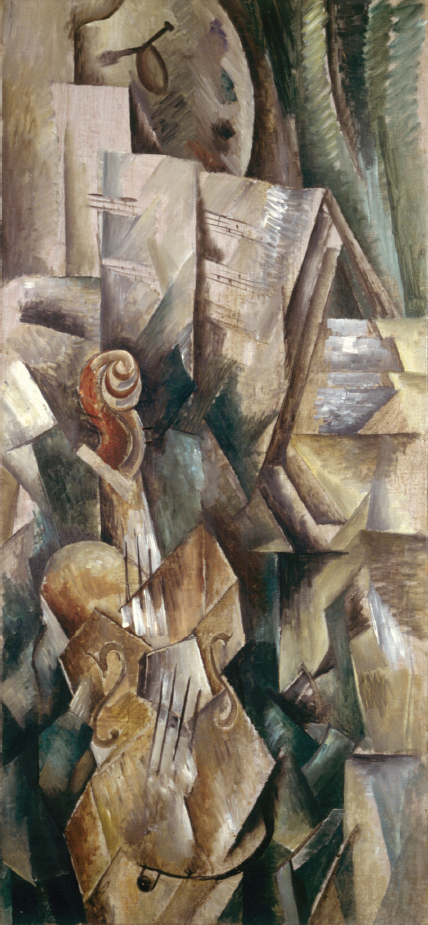3 | The Response of Modernism

Cubism was one of the earliest styles of abstract or near-abstract art, developed around 1910 by Pablo Picasso, Georges Braque, and others. It presented objects — in this painting by Braque, a violin and a musical score — as intersecting geometrical forms (not only cubes!), as if viewed simultaneously from several perspectives. Interestingly, Braque does not treat the artist’s palette at the top in cubist fashion. Solomon R. Guggenheim Museum, New York, USA/Mondadori Portfolio/Walter Mori/The Bridgeman Art Library.
If the traditional laws of physics, biblical authority, and psychological certainty could no longer be accepted, it seemed a small enough step to question the rules and assumptions surrounding the arts.
One such assumption was that visual art had to represent something from the external world. Once this idea was questioned, and then abandoned, the materials of painting and the other arts could be used for themselves — and a world of abstract painting opened up. (It is also called “nonrepresentational,” because it doesn’t faithfully represent objects in the world.) Avant-garde artists developed whole new languages for art — for example, the language of cubism, shown here in the painting by Georges Braque.
In literature, the basic assumption was that poets and novelists would use ordinary sentence structure, syntax, and grammar. Freedom from these assumptions opened up a whole new sphere of suggestion in tune with Freud’s ideas about the mind’s unconscious and irrational impulses. James Joyce’s novel Ulysses of 1922 is one of the most famous instances of the so-called stream-of-consciousness method of writing. His last novel, Finnegans Wake, makes use of a language that is half English and half words he invented.
In music, the basic assumptions concerned the composing of melody and its close associates harmony and tonality. These assumptions too were thrown into doubt, and the logic of earlier musical styles was questioned or even rejected. Some avant-garde composers turned away from conventional presentation of rhythm and meter, while others wrote melodies that carried to new lengths the most complex of late Romantic melodic designs. Still others devised new harmonies more complicated and dissonant than those of earlier generations, or even harmonies derived from new scales, different from the major and minor.
There was a tendency about this time for artists of various kinds to join together in formal or informal groups, both for mutual encouragement and for the exchange of ideas. Thus Claude Debussy was friends with several avant-garde poets. Schoenberg, himself a painter as well as a musician, associated with a group of artists who set forth their ideas in The Blue Rider, a magazine named after a picture by the pioneer nonrepresentational painter Vasily Kandinsky (see page 308). Stravinsky and Maurice Ravel belonged to a group who called themselves the Apaches. With all this interchange, it is not surprising that one can sometimes detect similar tendencies in music and the other arts.
